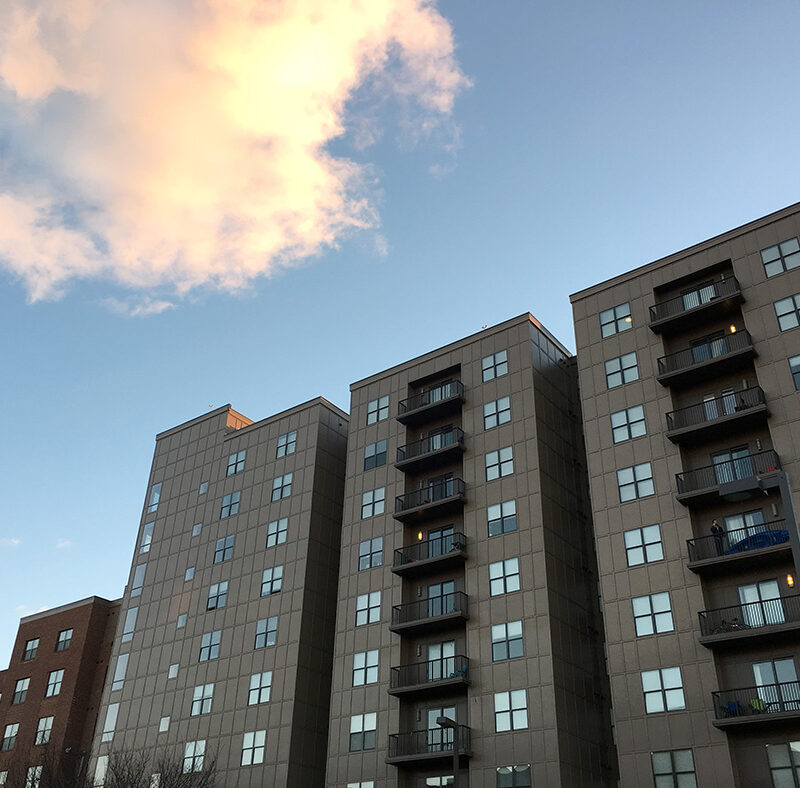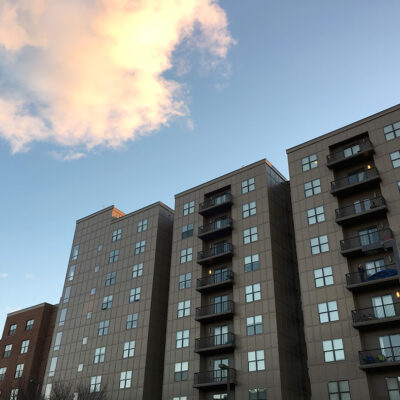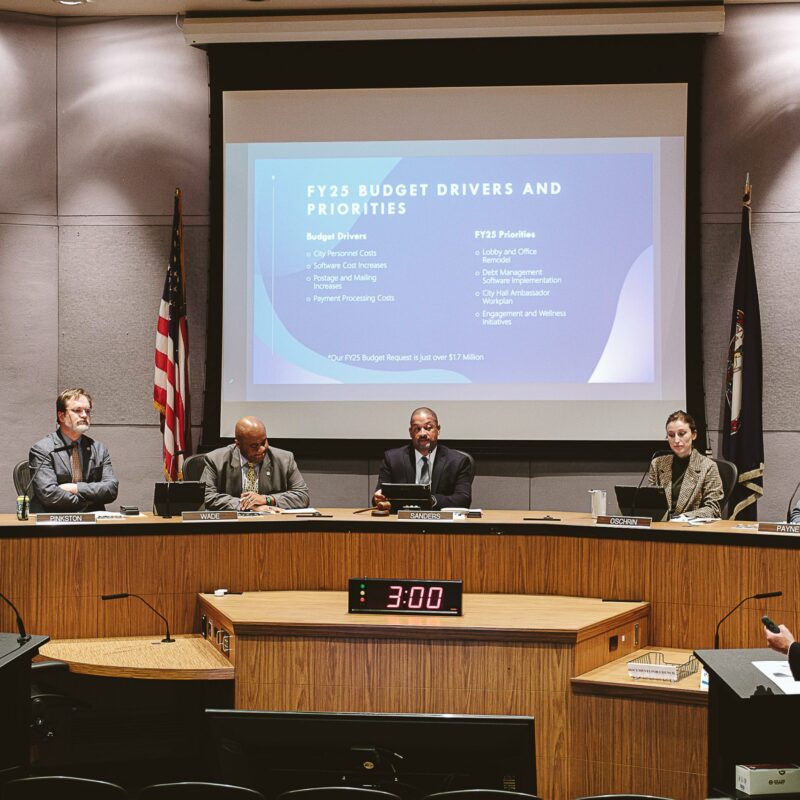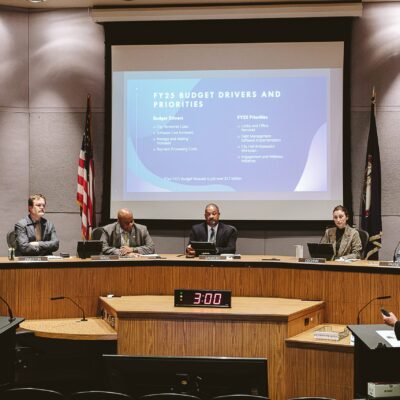When Belmont resident Brian Wimer saw Norfolk-based MMM Design Group’s proposal for a new bridge connecting his neighborhood to the Downtown Mall, he wasn’t impressed. Wimer had spent the better part of a year attending focus groups that were supposed to inform the project, and he felt himself getting angry as the City Council announced that MMM’s design would move on to the Board of Architectural review last November.
People had requested sidewalks, bike lanes, and more space, and they got what they asked for. But Wimer said no one was satisfied with the outcome.
“Everybody got their little piece, but they looked at the solution and it was awful. I mean the solution was essentially what we have now,” Wimer said.
A pony-tailed spire of a man who uses the title “primary instigator” to describe his role at his film production company, Wimer is anything but passive.
“We could just raise a stink and say, ‘That’s terrible. We hate your design.’ But I come from a more pragmatic background where I said, ‘Let’s provide a solution,’” Wimer said. “The obvious thing was to have a design competition.”
|
Spanish architect Eduardo Arroya (left), founder of the architecture firm NO.MAD, engaged students and faculty members from UVA’s School of Architecture and School of Landscape Architecture in "Belmont Vortex," which will produce 29 entries in the Belmont Bridge Design Competition. (Photo by Nick Strocchia) |
Wimer booked space at The Bridge, the Belmont-based arts nonprofit, and put up the initial money for the contest, which had a December deadline.
Meanwhile, across town, UVA School of Architecture’s department chair Inaki Alday spent last semester planning a practical learning workshop that would engage his graduate and undergraduate students under the direction of Spanish architect Eduardo Arroyo, widely acclaimed for his work on public spaces outside of his native Bilbao. Arroyo wanted to work on a local problem.
A light bulb flashed on in the head of Associate Professor Maurice Cox, a former Charlottesville mayor who knew about the Belmont Bridge discussion and Wimer’s contest.
“I said, ‘I think we’ve got an incredible local case that’s complex enough and important enough for the city and the local interest to engage the entire school,’” Cox said.
After getting the O.K. from Alday, Cox asked Wimer to push the deadline back and Wimer, who had already received submissions from design firms in San Francsico, Brooklyn, and Scotland, agreed.
Two weeks ago the entire UVA School of Architecture got together to kick off Belmont Vortex, a learning experience in which roughly 300 students are working in 29 teams under Arroyo’s direction to generate submissions for the Belmont Bridge Design Competition.
“We’ve never marshaled 300 students and 30 faculty to focus on a part of the city. I think it’s a fantastic model to generate extraordinary ideas that may actually change the course of an important piece of Charlottesville,” Cox said.
The experience has turned the school upside down, requiring the students to clear their work stations (highly personalized drafting tables) and to work in close collaboration across the semi-sacred line that divides the undergraduate and master’s programs.
Erin Root, a master’s student in landscape architecture who finished her architecture degree last May, said her colleagues have embraced the challenge.
“There’s this kind of buzz of excitement because people want to solve the problem. That’s why we’re here,” Root said.
Root’s not new to using the city as a classroom. Last year, she studied the history of Vinegar Hill in Elizabeth Meyer’s landscape architecture class and focused on how the redevelopment created an artificial barrier between the Downtown and the 10th and Page communities.
“I think this is not so much about the bridge itself but about the larger context of Charlottesville, mainly because the city is such an attainable scale that you can walk or bike or run anywhere,” Root said.
Root was working as part of Team 6, headed up by Associate Professor Anselmo Canfora. The team generated the idea of a “squishy joint” as a solution to the problem the bridge poses.
“I’m a firm believer in closing the gap between the academy and issues on the ground that affect the community and I think the workshop is creating a stronger bond between the school and the city because everyone is involved in this problem together,” said Canfora.
Team 6 had assembled an array of drawings, models, and computer animated solutions at their station when Arroyo, the master, arrived and essentially asked them to start from scratch.
“We like our processes, but processes can also make very bad solutions,” he said, with the physical presence of Antonio Banderas playing an architect in an Almodovar film.
“You have to frame the project in a very concrete way and then you make only one solution.”
Arroyo urged the students to get their story straight and then make a case that wouldn’t bog down in architect-speak or abstraction.
“We are talking to the public. We aren’t just talking to architects, so the public has to feel that something is happening here,” he said.
One team, one entry. Arroyo had 28 more consultations.
Theory and practice
For Wimer, the real impetus behind the competition is to push for a solution that re-imagines the bridge as a point of contact between Belmont and the Downtown Mall, something he feels the MMM design didn’t accomplish.
“What we have for the bridge now is a bypass. It essentially takes people right by the center of town and past it. And VDOT would say that’s fine because it’s facilitating automobile traffic. But what about people traffic?” Wimer asked.
James Moore, a second year landscape design student in the master’s program, lives in Belmont and rides his bicycle across the bridge every day on the way to school. Moore is realistic about the way the competition will inform the city’s final decision on redeveloping the site.
“I have some good friends who worked on the MMM proposal and I’m very aware of the constraints they faced from their side of things versus all the possibilities we’re bringing up,” he said. “I guess the thing I hope for is that a really great conversation comes out of this and the city gets excited about things and people get excited about a couple ideas and there’s some consensus to push behind.”
Kurt Marsh, a fourth year dual program student framed the challenge that his team faced in conceiving a solution.
“I think from the theoretical standpoint the site and the competition is really interesting because of the potential of continuing an idea of the Mall as a public space for Charlottesville across what is a divide presented by the railroad and some interesting topography changes,” Marsh said.
Cox deserves a large measure of credit for the way the architecture school has embraced the project. As mayor, he oversaw the McIntire Park master planning process, which ended up as a cause of frustration and a point of pride for him. Far from dampening his hopes, he believes the bridge design competition can be a game-changer.
“I hope it becomes the catalyst for the total transformation of the area,” Cox said. “I think that it’s highly likely that amongst the various proposals, there will be the germ of an idea that nobody has thought of that might be transformative and give the city the courage to make a bold move.”
And then there’s Wimer, the primary instigator, who doesn’t think the city can move forward with the MMM plan after people see what’s possible.
“Once you have seen that vision as a model and then for the city to come back and say, ‘We’re going to give you what you used to have, that old bridge. And we’re going to pay a million bucks to the people who designed it and we’re going to pay $14 million of your taxes to build it…’ I just don’t see it,” he said.
Belmont Bridge Design Competition entries are on display at the CitySpace Gallery from February 13-19. People’s choice and jury awards will be announced at 8pm on Sunday, February 19. Jury members include: UVA architecture faculty members Peter Waldman and Phoebe Crisman; Belmont-Carlton Neighborhood Association President Greg Jackson; Downtown Business Association member Joan Fenton; Heather Higgins of Bike Charlottesville; Bridge PAI co-founder Zack Worrell; and Brian Wimer.
Spanish architect Eduardo Arroyo (left), founder of the architecture firm NO.MAD, engaged students and faculty members from UVA’s School of Architecture and School of Landscape Architecture in “Belmont Vortex,” which will produce 29 entries in the Belmont Bridge Design Competition.






